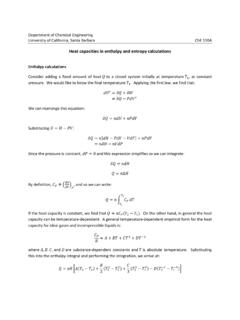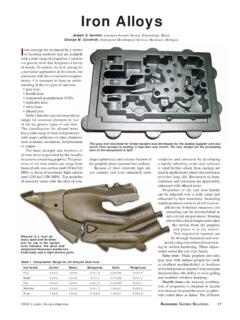Transcription of CHAPTER 7: Fixed-Bed Catalytic ReactorsI
1 CHAPTER 7: Fixed-Bed Catalytic Reactors ICopyright 2022 by Nob Hill Publishing, LLCIn a Fixed-Bed reactor the catalyst pellets are held in place and do not move withrespect to a fixed reference and energy balances are required for both the fluid, which occupies theinterstitial region between catalyst particles, and the catalyst particles, in which thereactions following figure presents several views of the Fixed-Bed reactor. The speciesproduction rates in the bulk fluid areessentially zero. That is the reason we areusing a / 161 CHAPTER 7: Fixed-Bed Catalytic Reactors IICopyright 2022 by Nob Hill Publishing, LLCBAcjsDCcjcjTR T cjFigure : Expanded views of a Fixed-Bed / 161 The physical pictureEssentially all reaction occurs within the catalyst particles.
2 The fluid in contact withthe external surface of the catalyst pellet is denoted with we need to discuss both fluid and pellet concentrations and temperatures, weuse a tilde on the variables within the catalyst / 161 The steps to considerDuring any Catalytic reaction the following steps occur:1transport of reactants and energy from the bulk fluid up to the catalyst pelletexterior surface,2transport of reactants and energy from the external surface into the porous pellet,3adsorption, chemical reaction, and desorption of products at the Catalytic sites,4transport of products from the catalyst interior to the external surface of the pellet,and5transport of products into the bulk coupling of transport processes with chemical reaction can lead to concentration andtemperature gradients within the pellet, between the surface and the bulk.
3 Or / 161 Some terminology and rate limiting stepsUsually one or at most two of the five steps are rate limiting and act to influence theoverall rate of reaction in the pellet. The other steps are inherently faster than theslow step(s) and can accommodate any change in the rate of the slow system isintraparticle transport controlledif step 2 is the slow process(sometimes referred to as diffusion limited).Forkinetic or reaction control, step 3 is the slowest , if step 1 is the slowest process, the reaction is said to beexternally / 161 Effective catalyst propertiesIn this CHAPTER , we model the system on the scale of Figure C.
4 The problem issolved for one pellet by averaging the microscopic processes that occur on the scaleof level D over the volume of the pellet or over a solid surface volume procedure requires an effective diffusion coefficient,Dj, to be identified thatcontains information about the physical diffusion process and pore / 161 Catalyst PropertiesTo make a Catalytic process commercially viable, the number of sites per unitreactor volume should be such that the rate of product formation is on the order of1 mol/L hour [12].In the case of metal catalysts, the metal is generally dispersed onto a high-area oxidesuch as alumina.
5 Metal oxides also can be dispersed on a second carrier oxide suchas vanadia supported on titania, or it can be made into a high-area carrier oxides can have surface areas ranging from m2/g to greater than100 m2 carrier oxides generally are pressed into shapes or extruded into / 161 Catalyst PropertiesThe following shapes are frequently used in applications:20 100 m diameter spheres for fluidized-bed cm diameter spheres for Fixed-Bed cm diameter cylinders with a length-to-diameter ratio of 3 4up to cm diameter hollow cylinders or lists some of the important commercial catalysts and their uses [7].
6 8 / 161 CatalystReactionMetals ( , Ni, Pd, Pt, as powdersCC bond hydrogenation, ,or on supports) or metal oxidesolefin +H2 paraffin( ,Cr2O3)Metals ( , Cu, Ni, Pt)CO bond hydrogenation, ,acetone +H2 isopropanolMetal ( , Pd, Pt)Complete oxidation of hydrocarbons,oxidation of COFe (supported and promoted with3H2+N2 2NH3alkali metals)NiCO+ 3H2 CH4+H2O(methanation)Fe or Co (supported and promotedCO+H2 paraffins + olefins +H2 Owith alkali metals)+CO2(+ other oxygen-containing organiccompounds) (Fischer-Tropsch reaction)Cu (supported on ZnO, with otherCO+ 2H2 CH3 OHcomponents, ,Al2O3)Re + Pt (supported on -Al2O3orParaffin dehydrogenation, isomerization -Al2O3promoted with chloride)and dehydrocyclization9 / 161 CatalystReactionSolid acids ( ,SiO2-Al2O3, zeolites)Paraffin cracking and isomerization -Al2O3 Alcohol olefin +H2 OPd supported on acidic zeoliteParaffin hydrocrackingMetal-oxide-supported complexes ofOlefin polymerization,Cr, Ti or , ethylene polyethyleneMetal-oxide-supported oxides ofOlefin metathesis,W or , 2 propylene ethylene + buteneAg(on inert support, promoted byEthylene + 1/2O2 ethylene oxidealkali metals)(withCO2+H2O)V2O5orPt2SO2+O2 2SO3V2O5(on metal oxide support)
7 Naphthalene + 9/2O2 phthalic anhydride+ 2CO2+2H2 OBismuth molybdatePropylene + 1/2O2 acroleinMixed oxides of Fe and MoCH3OH+O2 formaldehyde(withCO2+H2O)Fe3O4or metal sulfidesH2O+CO H2+CO2 Table : Industrial reactions over heterogeneous catalysts. This material is used by permissionof John Wiley & Sons, Inc., Copyright 1992 [7].10 / 161 Physical propertiesFigure D of shows a schematic representation of the cross section of a solid density is denoted pellet volume consists of both void and solid. The pellet void fraction (orporosity) is denoted by and = pVgin which pis the effective particle or pellet density andVgis the pore pore structure is a strong function of the preparation method, and catalysts canhave pore volumes (Vg) ranging from 1 cm3/g / 161 Pore propertiesThe pores can be the same size or there can be a bimodal distribution with pores oftwo different sizes, a large size to facilitate transport and a small size to contain theactive catalyst sizes can be as small as molecular dimensions (several Angstr oms)
8 Or as largeas several catalyst area is generally determined using a physically adsorbed species, suchasN2. The procedure was developed in the 1930s by Brunauer, Emmett and andTeller [5], and the isotherm they developed is referred to as the BET / 161 BAcjsDCcjcjTR T cjFigure: Expanded views of a Fixed-Bed / 161 Effective DiffusivityCatalyst 100 110 m powder packed into a boehmite G-58 Pd on e MeOH synthesis Pd on Pd on Ca : Porosity and tortuosity factors for diffusion in / 161 The General Balances in the Catalyst ParticleIn this section we consider the mass and energy balances that arise with diffusion in thesolid catalyst particle when considered at the scale of Figure the volume element depicted in the figureeNjEcj15 / 161 BalancesAssume a fixed laboratory coordinate system in which the velocities are defined and letvjbe the velocity of speciesjgiving rise to molar fluxNjNj=cjvj,j= 1,2.
9 ,nsLetEbe the total energy within the volume element andebe the flux of total energythrough the bounding surface due to all mechanisms of transport. The conservation ofmass and energy for the volume element implies cj t= Nj+Rj,j= 1,2,..,ns( ) E t= ein whichRjaccounts for the production of speciesjdue to chemical / 161 FluxesNext we consider the fluxes. Since we are considering the diffusion of mass in astationary, solid particle, we assume the mass flux is well approximated byNj= Dj cj,j= 1,2,..,nsin whichDjis an effective diffusivity for speciesj. We approximate the total energy fluxbye= k T+ jNjHjThis expression accounts for the transfer of heat by conduction, in which kis the effectivethermal conductivity of the solid, and transport of energy due to the mass / 161 Steady stateIn this CHAPTER , we are concerned mostly with the steady state.
10 Setting the timederivatives to zero and assuming constant thermodynamic properties produces0 =Dj 2cj+Rj,j= 1,2,..,ns( )0 = k 2T i HRiri( )In multiple-reaction, noniosthermal problems, we must solve these equations numerically,so the assumption of constant transport and thermodynamic properties is driven by thelack of data, and not analytical / 161 Single Reaction in an Isothermal ParticleWe start with the simplest cases and steadily remove restrictions and increase thegenerality. We consider in this section a single reaction taking place in case: the spherical particle, first-order reaction, without external we consider other catalyst shapes, then other reaction orders, and then otherkinetic expressions such as the Hougen-Watson kinetics of CHAPTER end the section by considering the effects of finite external mass / 161 First-Order Reaction in a Spherical ParticleAk B,r=kcA0 =Dj 2cj+Rj,j= 1,2.








